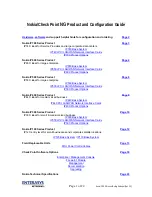
displayed next to the sensor in the output from the hwm command.
Controlling the Event Sending Frequency
The maximum frequency of log event generation when hardware monitoring values fall outside their
preset range can be limited using the AlarmRepeatInterval setting in the LogSettings object. This
setting is used because the monitored values are continuous.
For example, to change the interval from the default of 60 seconds to a new value of 900 seconds,
use the CLI command:
gw-world:/> set Settings LogSettings AlarmRepeatInterval=900
This means that a new event message must now wait for 900 seconds after the previous one has
been sent.
All the options for LogSettings can be found in Section 2.2.8, “Advanced Log Settings”.
2.4.4. Memory Monitoring Settings
The System > Hardware Monitoring section of the Web Interface provides the administrator with
a number of settings related to the monitoring of available memory. These are:
Memory Poll Interval
Memory polling interval which is the delay in minutes between readings of memory values.
Minimum 1, Maximum 200.
Default: 15 minutes
Memory Use Percentage
True if the memory monitor uses a percentage as the unit for monitoring, False if megabytes are
used. Applies to Alert Level, Critical Level and Warning Level.
Default: True
Memory Log Repetition
Should we send a log message for each poll result that is in the Alert, Critical or Warning level, or
should we only send when a new level is reached. If True, a message is sent each time Memory Poll
Interval is triggered. If False, a message is sent when a value goes from one level to another.
Default: False
Alert Level
Generate an Alert log message if free memory is below this number of bytes. Disable by setting to 0.
Maximum value is 10,000.
Default: 0
Critical Level
2.4.4. Memory Monitoring Settings
Chapter 2. Management and Maintenance
79
Summary of Contents for NetDefend DFL-1660
Page 28: ...1 3 NetDefendOS State Engine Packet Flow Chapter 1 NetDefendOS Overview 28 ...
Page 88: ...2 6 3 Restore to Factory Defaults Chapter 2 Management and Maintenance 88 ...
Page 166: ...3 10 DNS Chapter 3 Fundamentals 166 ...
Page 254: ...4 7 5 Advanced Settings for Transparent Mode Chapter 4 Routing 254 ...
Page 268: ...5 4 IP Pools Chapter 5 DHCP Services 268 ...
Page 368: ...6 7 Blacklisting Hosts and Networks Chapter 6 Security Mechanisms 368 ...
Page 390: ...7 4 7 SAT and FwdFast Rules Chapter 7 Address Translation 390 ...
Page 414: ...8 3 Customizing Authentication HTML Pages Chapter 8 User Authentication 414 ...
Page 490: ...9 8 6 Specific Symptoms Chapter 9 VPN 490 ...
Page 528: ...10 4 6 Setting Up SLB_SAT Rules Chapter 10 Traffic Management 528 ...
Page 544: ...11 7 HA Advanced Settings Chapter 11 High Availability 544 ...
Page 551: ...12 3 5 Limitations Chapter 12 ZoneDefense 551 ...
Page 574: ...Default 512 13 9 Miscellaneous Settings Chapter 13 Advanced Settings 574 ...
Page 575: ...13 9 Miscellaneous Settings Chapter 13 Advanced Settings 575 ...











































